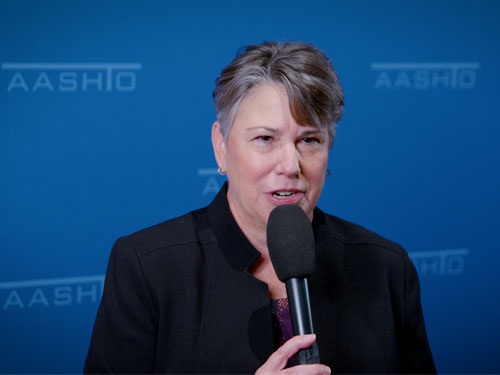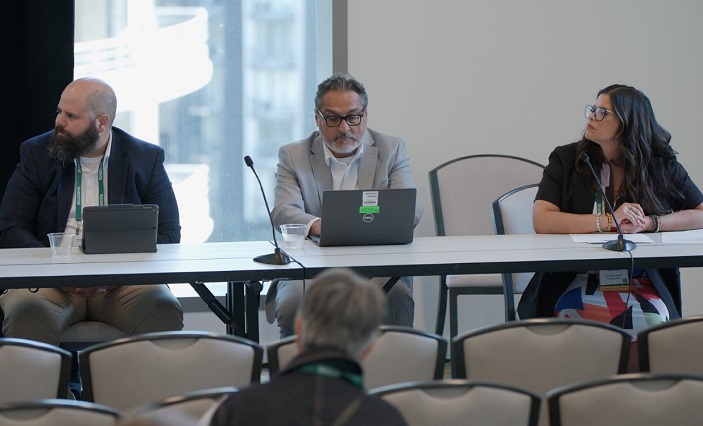The American Association of State Highway and Transportation Officials recently hosted a knowledge session at its 2023 Spring Meeting in Seattle that delved into ways state departments of transportation can attract and nurture an “engaged workforce.”
[Above photo by AASHTO]
“This is a really important topic, but there are a lot of different nuances to the [state DOT] workforce issue,” explained Mo Harmon, director of industry strategy for Bentley Systems, which sponsored this knowledge session.
“Attract, nurture, and engage – each of these words hits home in this industry,” he said. “How state DOTs keep their workforce is really tied to the word ‘engaged,’ for workers today need to enjoy what they are doing. We also have to look at the education part of this issue because of a lot of people don’t have the skills we need.”
James Fults – workforce programs and recruitment unit manager for the Michigan Department of Transportation and one of three panelists at the knowledge session – said one example of how serious workforce issues have become to state DOTs is that his position did not exist three years ago.
“There are just not enough people in the world to fill all the vacant positions we are facing – and this is not just a state DOT issue; it’s a global workforce issue,” he said.
For example, he noted that according to recent statistics roughly 25,000 new civil engineers will be needed every year for the next decade to fill the positions expected to be vacated by retirements.
“We have three huge engineering colleges in Michigan but not every engineer they graduate will want to become a civil engineer,” Fults explained. “So we are going to have to look at including different degrees and different career pathways to attract and keep the people we need. That’s going to require a completely different engagement effort, one that includes a lot of structural challenges – some that are under my control and some that are not.”
Peter Guzman, apprenticeship program director for the Washington State Department of Labor and Industries, noted that one of those “structural challenges” is that the younger cohort is “not enamored” of working in the trades. Yet he said that is where demand for workers is most acute; for construction laborers, carpenters, electricians, and operations engineers.
“There is a growing need for a lot of workers and apprenticeships offer a modality for getting us there,” Guzman explained. “And this need for workers is not just limited to the commercial/transportation sectors – there will be a big spike in residential construction jobs, too; all contributing to a really big spike in demand for workers.”
He said it is also “getting to point” that young people are starting to realize one does not have to go to a community college or a four-year university to make a decent living. “You can make a good wage being a blue collar worker – we’re getting that message out,” Guzman noted.
Still, a range of new challenges remain – especially in terms of the demand for more telework opportunities. “We just completed a preliminary survey of workers in our state and found 80 percent of the workforce does not want to be in the office,” he said. “That’s why engagement and nurturing are becoming key terms in workforce recruitment and retention efforts today.”
As a result, “workforce development” remains as one of three “key goals” mapped out by the Washington State Department of Transportation in its strategic plan, emphasized Alvina Mao.
“This is intentional because it is vital to the success of our agency,” explained Mao, WSDOT’s workforce development manager. “We rely heavily on our annual employee engagement survey so we can get the best data we can on our workforce needs. We hope to eventually include ‘spot polls’ in this process so we can focus more closely on certain areas such as the onboarding process, the work environment, the family leave experience – every part of the employee career path.”
Along with eliciting detailed feedback, Mao said WSDOT is focused on several efforts to increase workforce retention:
- Continuing to build a more “flexible and mobile work environment” through technology and innovation.
- Providing ongoing training and other learning opportunities, including mentorship opportunities. “Training used to be reserved for upper level of the agency,” Mao said. “Now it is applicable to every level of the organization.”
- Building up WSDOT as a “brand,” and as an ideal place to work for in the future.
- Increasing retention in key entry level classifications to reduce turnover and provide pathways to higher level jobs within the agency.
“We’re putting a lot of work into strengthening in-house training programs such as our ‘High School to Highways’ program,” she said. “We find by offering training reemphasizes that WSDOT ‘culture of belonging’ within our agency. It’s about providing people in entry level jobs with credentials developed in house so they can grow into new positions.”
 Top Stories
Top Stories
USDOT Makes $1.5B Worth of BUILD Grants Available
December 19, 2025 Top Stories
Top Stories

